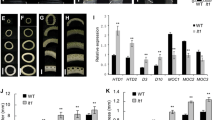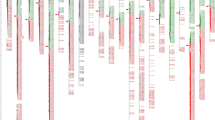Abstract
Key message
A tiller inhibition gene, TIN4, was mapped to an approximately 311 kb genomic interval on chromosome arm 2DL of wheat.
Abstract
The tiller is one of the key components of plant morphological architecture and a central agronomic trait affecting spike number in wheat. Low tiller number has been proposed as a major component of crop ideotypes for high yield potential. In this study, we characterized the development of tillering in near-isogenic lines (NIL7A and NIL7B), indicating that the TIN4 gene inhibited the growth of tillering buds and negatively regulated tiller number. Low-tillering was controlled by a single gene (TIN4) located on chromosome 2DL by genetic analysis and bulked segregant RNA-seq analysis. A total of 17 new polymorphic markers were developed in this study, and 61 recombinants were identified in the secondary F2 population containing 4,266 individuals. TIN4 was finally mapped on a 0.35 cM interval, co-segregated with molecular marker M380, within a 311 kb genomic interval of the wheat cultivar Chinese Spring reference genome sequence that contained twelve predicted genes. Yield experiments showed that the yield of low-tillering lines was higher than that of high-tillering lines at a higher density. Overall, this study provides a foundation for the construction of a low-tillering ideotype for improving wheat yield and further cloning TIN4 by map-based cloning approach.





Similar content being viewed by others
Data Availability
The sequencing datasets in this study can be accessed at the National Center for Biotechnology Information (NCBI) SRA repository under accession number PRJNA705399 and PRJNA657689.
References
Abe A, Kosugi S, Yoshida K, Natsume S, Takagi H, Kanzaki H, Matsumura H, Yoshida K, Mitsuoka C, Tamiru M (2012) Genome sequencing reveals agronomically important loci in rice using MutMap. Nat Biotechnol 30:174–178
An J, Niu H, Ni Y, Jiang Y, Zheng Y, He R, Li J, Jiao Z, Zhang J, Li H (2019) The miRNA–mRNA networks involving abnormal energy and hormone metabolisms restrict tillering in a wheat mutant dmc. Int J Mol Sci 20:4586
Arite T, Iwata H, Ohshima K, Maekawa M, Nakajima M, Kojima M, Sakakibara H, Kyozuka J (2007) DWARF10, an RMS1/MAX4/DAD1 ortholog, controls lateral bud outgrowth in rice. Plant J 51:1019–1029
Cieslak M, Seleznyova AN, Hanan J (2011) A functional–structural kiwifruit vine model integrating architecture, carbon dynamics and effects of the environment. Ann Bot 107:747–764
Donald CM (1968) The breeding of crop ideotypes. Euphytica 17:385–403
Duan E, Wang Y, Li X, Lin Q, Zhang T, Wang Y, Zhou C, Zhang H, Jiang L, Wang J (2019) OsSHI1 regulates plant architecture through modulating the transcriptional activity of IPA1 in rice. Plant Cell 31:1026–1042
Evers JB, van der Krol AR, Vos J, Struik PC (2011) Understanding shoot branching by modelling form and function. Trends Plant Sci 16:464–467
Gou X, Shi H, Yu S, Wang Z, Li C, Liu S, Ma J, Chen G, Liu T, Liu Y (2020) SSRMMD: a rapid and accurate algorithm for mining SSR feature loci and candidate polymorphic SSRs based on assembled sequences. Front Genet 11:706
Huang X, Cöster H, Ganal M, Röder M (2003) Advanced backcross QTL analysis for the identification of quantitative trait loci alleles from wild relatives of wheat (Triticum aestivum L.). Theor Appl Genet 106:1379–1389
Hubbard L, McSteen P, Doebley J, Hake S (2002) Expression patterns and mutant phenotype of teosinte branched1 correlate with growth suppression in maize and teosinte. Genetics 162:1927–1935
Hussien A, Tavakol E, Horner DS, Muñoz-Amatriaín M, Muehlbauer GJ, Rossini L (2014) Genetics of tillering in rice and barley. Plant Genome. https://doi.org/10.3835/plantgenome2013.10.0032
Hyles J, Vautrin S, Pettolino F, MacMillan C, Stachurski Z, Breen J, Berges H, Wicker T, Spielmeyer W (2017) Repeat-length variation in a wheat cellulose synthase-like gene is associated with altered tiller number and stem cell wall composition. J Exp Bot 68:1519–1529
Ishikawa S, Maekawa M, Arite T, Onishi K, Takamure I, Kyozuka J (2005) Suppression of tiller bud activity in tillering dwarf mutants of rice. Plant Cell Physiol 46:79–86
Kato K, Miura H, Sawada S (2000) Mapping QTLs controlling grain yield and its components on chromosome 5A of wheat. Theor Appl Genet 101:1114–1121
Kebrom TH, Chandler PM, Swain SM, King RW, Richards RA, Spielmeyer W (2012) Inhibition of tiller bud outgrowth in the tin mutant of wheat is associated with precocious internode development. Plant Physiol 160:308–318
Kuraparthy V, Sood S, Dhaliwal H, Chhuneja P, Gill BS (2007) Identification and mapping of a tiller inhibition gene (tin3) in wheat. Theor Appl Genet 114:285–294
Kuraparthy V, Sood S, Gill BS (2008) Genomic targeting and mapping of tiller inhibition gene (tin3) of wheat using ESTs and synteny with rice. Funct Integr Genomics 8:33–42
Lauri P-E, Costes E, Regnard J-L, Brun L, Simon S, Monney P, Sinoquet H (2008) Does knowledge on fruit tree architecture and its implications for orchard management improve horticultural sustainability? An overview of recent advances in the apple. I Int Symp Hortic Europe 817:243–250
Li H (2012) Exploring single-sample SNP and INDEL calling with whole-genome de novo assembly. Bioinformatics 28:1838–1844
Li X, Qian Q, Fu Z, Wang Y, Xiong G, Zeng D, Wang X, Liu X, Teng S, Hiroshi F (2003) Control of tillering in rice. Nature 422:618–621
Li H, Handsaker B, Wysoker A, Fennell T, Ruan J, Homer N, Marth G, Abecasis G, Durbin R (2009) The sequence alignment/map format and SAMtools. Bioinformatics 25:2078–2079
Li Z, Peng T, Xie Q, Han S, Tian J (2010) Mapping of QTL for tiller number at different stages of growth in wheat using double haploid and immortalized F 2 populations. J Genet 89:409
Liu G, Jia L, Lu L, Qin D, Zhang J, Guan P, Ni Z, Yao Y, Sun Q, Peng H (2014) Mapping QTLs of yield-related traits using RIL population derived from common wheat and Tibetan semi-wild wheat. Theor Appl Genet 127:2415–2432
Liu J, Luo W, Qin N, Ding P, Zhang H, Yang C, Mu Y, Tang H, Liu Y, Li W (2018) A 55 K SNP array-based genetic map and its utilization in QTL mapping for productive tiller number in common wheat. Theor Appl Genet 131:2439–2450
Liu J, Tang H, Qu X, Liu H, Li C, Tu Y, Li S, Habib A, Mu Y, Dai S (2020) A novel, major, and validated QTL for the effective tiller number located on chromosome arm 1BL in bread wheat. Plant Mol Biol 104:173–185
Mitchell J, Rebetzke G, Chapman S, Fukai S (2013) Evaluation of reduced-tillering (tin) wheat lines in managed, terminal water deficit environments. J Exp Bot 64:3439–3451
Murray M, Thompson WF (1980) Rapid isolation of high molecular weight plant DNA. Nucleic Acids Res 8:4321–4326
Narasimhan V, Danecek P, Scally A, Xue Y, Tyler-Smith C, Durbin R (2016) BCFtools/RoH: a hidden Markov model approach for detecting autozygosity from next-generation sequencing data. Bioinformatics 32:1749–1751
Naruoka Y, Talbert L, Lanning S, Blake N, Martin J, Sherman J (2011) Identification of quantitative trait loci for productive tiller number and its relationship to agronomic traits in spring wheat. Theor Appl Genet 123:1043
Nasseer A, Martin J, Heo H, Blake N, Sherman J, Pumphrey M, Kephart K, Lanning S, Naruoka Y, Talbert L (2016) Impact of a quantitative trait locus for tiller number on plasticity of agronomic traits in spring wheat. Crop Sci 56:595–602
Van Ooijen J (2006) JoinMap® 4, Software for the calculation of genetic linkage maps in experimental populations. Kyazma BV, Wageningen 33
Patel RK, Jain M (2012) NGS QC Toolkit: a toolkit for quality control of next generation sequencing data. PLoS ONE 7:e30619
Peng Z, Yen C, Yang J (1998) Genetic control of oligo-culms character in common wheat. Wheat Inf Serv 86:19–24
Ren T, Hu Y, Tang Y, Li C, Yan B, Ren Z, Tan F, Tang Z, Fu S, Li Z (2018) Utilization of a Wheat55K SNP array for mapping of major QTL for temporal expression of the tiller number. Front Plant Sci 9:333
Rönnqvist M (2003) Optimization in forestry. Math Program 97:267–284
Spielmeyer W, Richards R (2004) Comparative mapping of wheat chromosome 1AS which contains the tiller inhibition gene (tin) with rice chromosome 5S. Theor Appl Genet 109:1303–1310
Tan C-T, Yu H, Yang Y, Xu X, Chen M, Rudd JC, Xue Q, Ibrahim AM, Garza L, Wang S (2017) Development and validation of KASP markers for the greenbug resistance gene Gb7 and the hessian fly resistance gene H32 in wheat. Theor Appl Genet 130:1867–1884
Wang Z, Liu Y, Shi H, Mo H, Wu F, Lin Y, Gao S, Wang J, Wei Y, Liu C (2016) Identification and validation of novel low-tiller number QTL in common wheat. Theor Appl Genet 129:603–612
Wang B, Smith SM, Li J (2018) Genetic regulation of shoot architecture. Annu Rev Plant Biol 69:437–468
Wang Z, Shi H, Yu S, Zhou W, Li J, Liu S, Deng M, Ma J, Wei Y, Zheng Y (2019) Comprehensive transcriptomics, proteomics, and metabolomics analyses of the mechanisms regulating tiller production in low-tillering wheat. Theor Appl Genet 132:2181–2193
Yan J (2017) A functional–structural kiwifruit vine model integrating architecture, carbon dynamics and effects of the environment. China Agriculture Press
Zadoks JC, Chang TT, Konzak CF (1974) A decimal code for the growth stages of cereals. Weed Res 14:415–421
Zhang J, Wu J, Liu W, Lu X, Yang X, Gao A, Li X, Lu Y, Li L (2013) Genetic mapping of a fertile tiller inhibition gene, ftin, in wheat. Mol Breeding 31:441–449
Zhang L, Yu H, Ma B, Liu G, Wang J, Wang J, Gao R, Li J, Liu J, Xu J (2017) A natural tandem array alleviates epigenetic repression of IPA1 and leads to superior yielding rice. Nat Commun 8:1–10
Zhao B, Wu TT, Ma SS, Jiang DJ, Bie XM, Sui N, Zhang XS, Wang F (2020) TaD27-B gene controls the tiller number in hexaploid wheat. Plant Biotechnol J 18:513–525
Zhou W, Shi H, Wang Z, Zhao Y, Gou X, Li C, Chen G, Liu S, Deng M, Ma J (2020) Identification of lncRNAs involved in wheat tillering development in two pairs of near-isogenic lines. Funct Integr Genomics 20:669–679
Acknowledgements
This study was supported by the National Natural Science Foundation of China (31771794), and the Key Research and Development Program of Sichuan Province (2021YFN0034 and 21ZDYF3575).
Author information
Authors and Affiliations
Contributions
ZQW and FKW drafted and revised the manuscript, and mainly responsible for data analysis; XDC, WLZ, YL, SH, SFY and HZ performed the experiments; HRS and CXL participated in data analysis; YXL conceived and coordinated the project, and revised the manuscript; and all authors read and approved the final manuscript for publication.
Corresponding author
Ethics declarations
Conflict of interest
All authors declare that there is no conflict of interest.
Ethical Approval
The authors declare that the experiments comply with the current laws of the country in which they were performed.
Additional information
Communicated by Takao Komatsuda.
Publisher's Note
Springer Nature remains neutral with regard to jurisdictional claims in published maps and institutional affiliations.
Supplementary Information
Below is the link to the electronic supplementary material.
Rights and permissions
About this article
Cite this article
Wang, Z., Wu, F., Chen, X. et al. Fine mapping of the tiller inhibition gene TIN4 contributing to ideal plant architecture in common wheat. Theor Appl Genet 135, 527–535 (2022). https://doi.org/10.1007/s00122-021-03981-1
Received:
Accepted:
Published:
Issue Date:
DOI: https://doi.org/10.1007/s00122-021-03981-1




